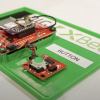As we continue with the micro:bit series, we look at another onboard feature: the temperature sensor. Interestingly, there is no separate chip for the temperature sensor. Instead, we read from the temperature sensor built into the main processor (nRF51822). While it was originally intended for detecting overheating, we can use it to get an idea of the ambient temperature (just make sure you're not taxing the processor, as you'll really start throwing off the readings with the extra heat).
In addition to reading temperatures, the micro:bit is capable of controlling small servos. We can use alligator clips to make connections to the pads or use #4--40 screws to more permanently attach wires. I say "small servos" because the sub-micro servos seem to function with the provided 3--3.3V from the micro:bit. If you need better torque (and actually want to operate the servo in the specified voltage range), you'll need to find another power source that can provide 4.8--6V.
That being said, the small servos (even at 3V) seem to perform adequately for moving small loads, such as Popsicle sticks and cardboard. In the video, you can see that I glued a Popsicle stick to the servo's arm and mounted it to a cardboard backing to create a more visually appealing temperature gauge.
Because I love the idea that I can share an interactive version of my code complete with simulator, here is the temperature gauge program from the video:
The micro:bit is still on pre-order, but you can click here to learn more about it.
For anyone who has used servos with students in the classroom, clubs, etc., what kinds of projects have worked well? What materials (e.g., cardboard) do they enjoy using with the servo? Please share your thoughts in the comments below.









I have a micro:bit and it works great. Got it this week from Adafruit. Those people over there are great. They even had the edge connector for it. Which I also bought. So far I have made a faceplate for it with my 3D printer. I made a compass out of it. I used the temperature sensor for a thermometer. I also found a few bugs. But this little 32 bit processor is quite the interesting device. Reminds me of the Sinclair ZX80 I had. Those Brits are always coming up with something unusual. I suggest checking it out.